


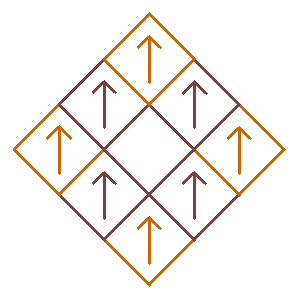
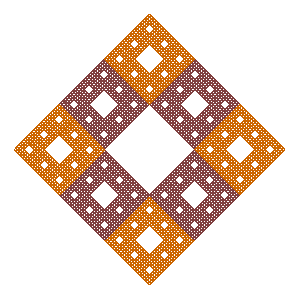
The image on the right shows the basic design of the remaining initial squares considered to have an upward orientation. But suppose the top square is removed rather than the middle square. Iterating that construction would produce a different fractal.


In general, we can choose to remove from 1 to 8 squares to form the basic design. In addition, however, we can also choose to rotate any of the remaining squares by 90° counterclockwise, by 180°, or by 270° counterclockwise (i.e. 90° clockwise) as that will maintain their relative positions, but change their orientation. For example, suppose only the top square is removed as before, but now the three squares in the middle row are rotated by 90°, 180°, and 270° counterclockwise respectively as illustrated in the design below along with the first four iterations. View the animation to see how the arrows are rotated during these four iterations, and view the video to see how the eight scaled hearts fill their respective squares while points are plotted using the chaos game algorithm with the IFS described below.
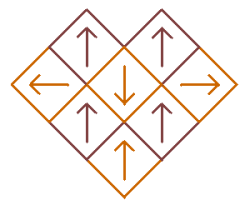



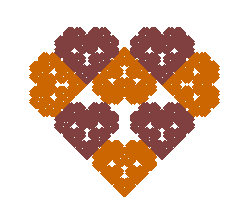
Because we are only interested in symmetric fractals, we will always require that the basic design be symmetric with respect to a vertical line through the middle. Because of this symmetry requirement, any horizontal, vertical, or diagonal reflection of a square can be represented instead by one of the four rotations of a square [details].
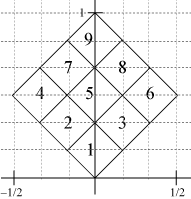 Take the initial square to have diagonals of length 1 and bottom vertex at the origin. If the nine squares are labeled from 1 to 9 as shown to the right, then each of the functions corresponding to a particular square can be indexed by the same number as the triangle. This gives the nine functions below. The translation vectors are determined by how the bottom vertex of square 1 has to be moved to the bottom vertices of the other eight squares. Each gridline corresponds to 1/6.
Take the initial square to have diagonals of length 1 and bottom vertex at the origin. If the nine squares are labeled from 1 to 9 as shown to the right, then each of the functions corresponding to a particular square can be indexed by the same number as the triangle. This gives the nine functions below. The translation vectors are determined by how the bottom vertex of square 1 has to be moved to the bottom vertices of the other eight squares. Each gridline corresponds to 1/6.
Use the dropdown menus to chose 0°, 90°, 180°, or 270° depending on how a square is to be rotated. If a square is to be deleted, choose "Remove" from the menu. Finally, click on the "Create IFS" button. The IFS for that fractal will consist of the functions below whose indices match those of the remaining squares and for which the appropriate angle of rotation is specified.
| 1. | \({f_1}({\bf{x}}) =\displaystyle \left[ {\begin{array}{*{20}{c}} {1/3} & {0} \\ {0} & {1/3} \\ \end{array}} \right]{\bf{x}} + \left[ {\begin{array}{*{20}{c}} {0} \\ {0} \\ \end{array}} \right]\) | scale by 1/3, rotate by \(\theta_1\) = | |
| 2. | \({f_2}({\bf{x}}) =\displaystyle \left[ {\begin{array}{*{20}{c}} {1/3} & {0} \\ {0} & {1/3} \\ \end{array}} \right]{\bf{x}} + \left[ {\begin{array}{*{20}{c}} {-1/6} \\ {1/6} \\ \end{array}} \right]\) | scale by 1/3, rotate by \(\theta_2\) = | |
| 3. | \({f_3}({\bf{x}}) =\displaystyle \left[ {\begin{array}{*{20}{c}} {1/3} & {0} \\ {0} & {1/3} \\ \end{array}} \right]{\bf{x}} + \left[ {\begin{array}{*{20}{c}} {1/6} \\ {1/6} \\ \end{array}} \right]\) | scale by 1/3, rotate by \(\theta_3\) = | |
| 4. | \({f_4}({\bf{x}}) =\displaystyle \left[ {\begin{array}{*{20}{c}} {1/3} & {0} \\ {0} & {1/3} \\ \end{array}} \right]{\bf{x}} + \left[ {\begin{array}{*{20}{c}} {-1/3} \\ {1/3} \\ \end{array}} \right]\) | scale by 1/3, rotate by \(\theta_4\) = | |
| 5. | \({f_5}({\bf{x}}) =\displaystyle \left[ {\begin{array}{*{20}{c}} {1/3} & {0} \\ {0} & {1/3} \\ \end{array}} \right]{\bf{x}} + \left[ {\begin{array}{*{20}{c}} {0} \\ {1/3} \\ \end{array}} \right]\) | scale by 1/3, rotate by \(\theta_5\) = | |
| 6. | \({f_6}({\bf{x}}) =\displaystyle \left[ {\begin{array}{*{20}{c}} {1/3} & {0} \\ {0} & {1/3} \\ \end{array}} \right]{\bf{x}} + \left[ {\begin{array}{*{20}{c}} {1/3} \\ {1/3} \\ \end{array}} \right]\) | scale by 1/3, rotate by \(\theta_6\) = | |
| 7. | \({f_7}({\bf{x}}) =\displaystyle \left[ {\begin{array}{*{20}{c}} {1/3} & {0} \\ {0} & {1/3} \\ \end{array}} \right]{\bf{x}} + \left[ {\begin{array}{*{20}{c}} {-1/6} \\ {1/2} \\ \end{array}} \right]\) | scale by 1/3, rotate by \(\theta_7\) = | |
| 8. | \({f_8}({\bf{x}}) =\displaystyle \left[ {\begin{array}{*{20}{c}} {1/3} & {0} \\ {0} & {1/3} \\ \end{array}} \right]{\bf{x}} + \left[ {\begin{array}{*{20}{c}} {1/6} \\ {1/2} \\ \end{array}} \right]\) | scale by 1/3, rotate by \(\theta_8\) = | |
| 9. | \({f_9}({\bf{x}}) =\displaystyle \left[ {\begin{array}{*{20}{c}} {1/3} & {0} \\ {0} & {1/3} \\ \end{array}} \right]{\bf{x}} + \left[ {\begin{array}{*{20}{c}} {0} \\ {2/3} \\ \end{array}} \right]\) | scale by 1/3, rotate by \(\theta_9\) = |
| Label | Meaning |
|---|---|
| 1 | Rotate 0° |
| 2 | Rotate 90° |
| 3 | Rotate 180° |
| 4 | Rotate 270° |
| x | Remove square |
So the Sierpinski Carpet would be labeled as 111-1x1-111 (dashes added to help readability). The "heart" shaped fractal shown above would be labeled as 111-234-11x.
$$\sum\limits_{k = 1}^{9-m} {{r^d}} = 1\quad \Rightarrow \quad d = \frac{{\log (1/(9-m))}}{{\log (r)}} = \frac{{\log (9-m)}}{{\log (3)}}$$
How many examples are possible? There are \(\displaystyle \binom{9}{k}\) possible choices for how to remove \(k\) squares. Each of the remaining \(9-k\) squares can be rotated by one of 4 different angles (0, 90, 180, or 270). Assuming that only between 1 and 7 squares are removed, the total number of possibilities is \[\sum_{k=1}^7 \binom{9}{k}4^{9-k} = 1,690,944.\] However, this counts many designs that are not symmetric with respect to a vertical line through the middle of the initial square. In addition, some designs produce the same fractal and therefore should only be counted once. For example, if only the middle square is removed (square 5 in the illustration above), then the resulting fractal will be the Sierpinski carpet regardless of how the other eight squares are rotated (and there are 48=65536 different ways to rotate those eight squares!). Finally, some of the fractals are just reflections across the horizontal line through the middle of the original square and therefore not really distinct images. For example, the following two fractals are such reflections. On the left, squares 7 and 8 were removed at each iteration and five other squares were rotated, while on the right, squares 2 and 3 were removed at each iteration and five other squares were rotated. Click on the fractal on the right to see its reflection. We would not want to count these as separate examples.
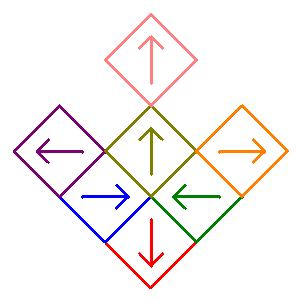

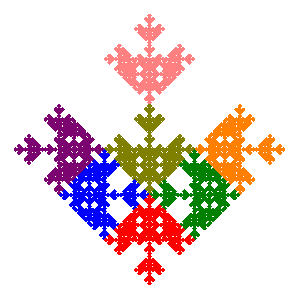
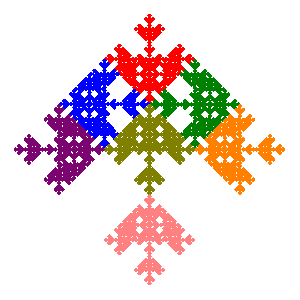
[Another view]
[Another view with squares]
[IFS video demonstration]
Click on "Another view" to see a version of the fractal above that was drawn using the chaos game algorithm to plot over 350,000 points which were colored using the idea of "color stealing" developed by Michael Barnsley. The fractal consists of seven self-similar pieces which are easy to spot when each piece is colored differently. Click on "Another view with squares" to see the same image but with the nine squares superimposed on top of the fractal, with each self-similar piece contained entirely within a square. Finally, click on "IFS video demonstration" to see the first five iterations of the IFS construction of the fractal.
The following chart shows the total number of distinct symmetric fractals when removing from 1 to 7 squares and using possible rotations at each iteration for a total of 1086 possible fractals [Details].
| squares removed | 1 | 2 | 3 | 4 | 5 | 6 | 7 |
| number of fractals | 257 | 326 | 230 | 162 | 65 | 35 | 11 |
The two variations on the Sierpinski carpet that come from dividing the rotated square into nine subsquare pieces and dividing a right isosceles triangle into nine triangular pieces have some similarities in that the right isosceles triangle is half of the rotated square, and pairs of triangular pieces make up a subsquare. So it is not surprising that the family of Sierpinski carpet relatives shares some common fractals with the family that comes from subdividing the right isosceles triangle. Here are two examples.
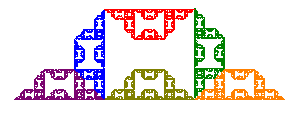
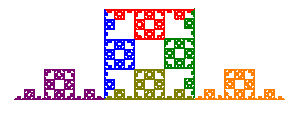
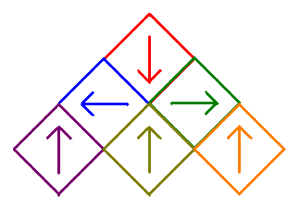
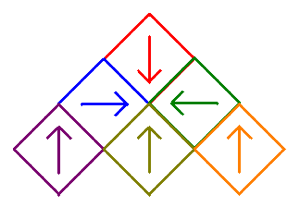


The second row shows the design as a Sierpinski carpet relative where the bottom three squares have been removed and squares 7, 8, and 9 have been rotated. The third row shows the design when starting with the isosceles right triangle divided into nine pieces with three being removed. The reason these give the same fractal is that each has an iterated function system with the same scaling and rotation matrices, but just with different translation vectors.